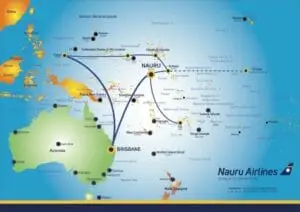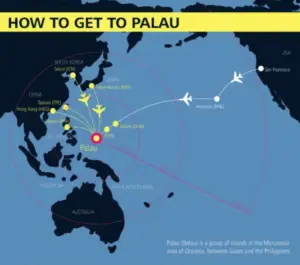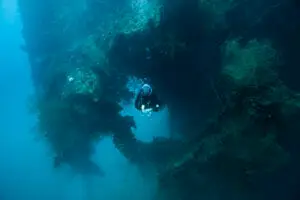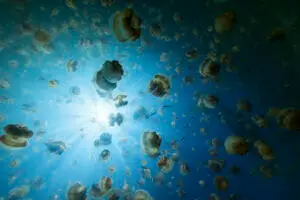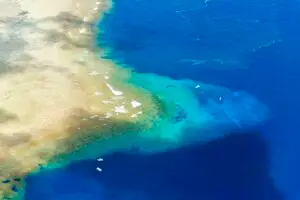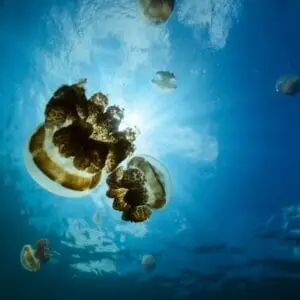There’s nothing quite like planning your next dive trip. The anticipation is building … You can’t wait. … because this time, you’re thinking of going BIG. You’re thinking about diving in Palau.
Palau, a remote island famous for its drift dives, plentiful sharks, mantas, beautiful walls, colourful reef fish, and wreck dives just to name a few of the diving attractions that make Palau truly one of the best dive spots in the world.
You’ve seen the way people gush about Palau online, saying how it’s a must, a dream, a bucket-list gem every diver needs to experience before they die.
At this point, you’re 99.9% sure it’s where you want to dive this year. But there’s still this nagging 0.1% that’s holding you back. It’s worried about the back-to-back flights.
The jet lag. The cost. The “hassle” Is Palau really worth it? Is it really as great as they say?
Well, if you’re looking for a truly unforgettable underwater adventure this year, the answer is yes, yes it is.
Diving in Palau is in one word “spectacular” It’s the stuff diver’s dreams are made of. Warm, crystal clear water, pristine reefs and drop-offs filled with incredible marine life and you have a 99% chance you will encounter large pelagics, especially sharks and mantas while gliding over the coral reefs of Palau.
If you are lucky, you might even encounter some of the rarer creatures like silvertip sharks, hammerheads or even the elusive dugong.
You will for sure find pristine reefs teeming with life and a generous smattering of amazing WW II wrecks, as well as dive sites where you can encounter strange critters, like frogfish and Mandarin fish.
Excited yet?
Read on to learn all you need to know about scuba diving in Palau
What Makes Diving Palau Different?
According to scuba diving magazine, Palau is in the top 3 of best dive destinations in the world. CNN even tipped Palau as a must-see destination for 2022.
The main reason why scuba divers from all over the world come to explore diving in Palau is because of its famous dive sites, healthy coral reefs and abundance of marine life including lots of sharks.
The main reason why you will see so many sharks is that the underwater ecosystems of Palau are so healthy. And that is only so because Palau has challenged the world with its stance on marine protection.
In 2009 Palau created the world’s first shark sanctuary, protecting over 135 Western Pacific shark species.
In early 2014 Palau declared an area the size of France a no commercial fishing zone. By doing this, the biggest marine sanctuary in the world was created.
The people of Palau actually care about the environment because their culture and their livelihood is so closely linked to the sea.
The people of Palau firmly believe in the old saying:
Diving in Palau - Table of Contents
"We did not inherit the earth from our parents, we borrow it from our children"
The People of Palau
And they mean business. As soon as you arrive in Palau and when you go through immigration you will be asked to sign a passport pledge where you promise you that as long as you are on the island you will behave in an ecologically and culturally responsible way for the sake of Palau’s children and future generations of Palauans.
When Is The Best Time to Visit Palau?
As you probably know Palau is located in the tropics, meaning, it gets a lot of rain year round. The good news is that about 70% of that rain falls at night and will not have an adverse impact on your Palau scuba diving holiday.
The bottom line is there is no real Palau diving season. Palau scuba diving is excellent year-round, and you may expect good dive conditions whenever you visit Palau.
As mentioned a minute ago Palau scuba diving is excellent year-round. But let’s have a look at some of the Palau weather averages
Palau average water and air temperatures
The average air temperature in Palau is 28°C all year round, with 29-30° during the day and 24-25° during the day.
The water temperature in Palau is a balmy 28° most of the year, which makes diving Palau comfortable year round.
The yearly rainfall in Palau averages around 3760 mm, which is quite a lot, and very typical for this part of the world.
As Palauan President Tommy Remengesau Jr said
“In Palau you can guarantee that you can catch a fish if you go fishing, but you can never guarantee what the weather will be.’
Although Palau lies outside the main typhoon tracks, it does occasionally get hit. We recommend bringing a good quality rain jacket when you visit Palau since it sometimes can get a little chilly in the evenings and on the dive boat.
While diving Palau is great all year round, different Palau diving seasons can be determined.
Let’s break down the 3 Palau diving Seasons.
The High Season
When you are in a luxury position to choose whenever you come the best time to come and dive in Palau would be from December to March.
During these months, diving in Palau is usually at its best, with calm, warm water and less rain.
The underwater visibility on the reefs during this time is often more than 40 meters. In the low season between July and September, the visibility can get “murky” and drop to anything between 15 and 20 meters.
But every upside has a downside, during these months, the hotels and resorts in Palau are usually a little pricier and dive sites a bit busier.
When you are planning to visit Palau during these months, make sure to book your accommodation well in advance.
Transitional months
During April, July, and August, October and November you can expect more rain, and the sea might get a little bit choppy. During these months, accommodation in Palau is usually easier to find, and some hotels in Palau are offering better prices.
The Low Season
May, June, September are the months with the most rain and wind, but on the upside, airfares and accommodation in Palau tend to be cheaper.
The dive sites will be less busy due to the fact fewer people decide to plan their vacation to Palau during this time.
But diving is still excellent, and the majority of dive sites can be reached most of the time!
Best dive sites in Palau?
The dive sites in Palau are known to be one of the last pure and untouched found in the Pacific. In 2015 a team of scientists from the Global Reef Expedition came to Palau and after doing a month of extensive research they concluded that the coral reefs in Palau are in excellent condition compared to other reefs in the region.
The research team even found that the average live coral cover in Palau was over 45% and reached a density up to 70% in some of the MPA’s (marine protected areas)
The percentage of coral cover is one of the highest in the world even compared to the world’s best coral reefs.
“WE HAVE DONE THOUSANDS OF DIVES ALL AROUND THE WORLD IN SOME OF THE MOST PRISTINE AREAS, BUT IN FEW PLACES WE HAVE SEEN WHAT WE HAVE SEEN HERE”
-Dr. Enric Sala, Explorer-in-Residence, National Geographic
To give you an idea NOAA says that Palau’s underwater world is blessed with
- 300 species of soft corals
- 1400 species of reef fishes
- 7 out of 9 of the world’s species of giant clams,
- The world’s most isolated colony of dugongs (a relative of the sea cow)
- Micronesia’s only saltwater crocodiles.
And to top that off Palau has the largest undisturbed forest and largest freshwater lake a.k.a Jellyfish lake in Micronesia, and 70 unique marine lakes.
NOAA doesn’t say anything about Sharks in Palau, but as mentioned earlier in this post the waters of Palau are one big shark sanctuary and you have a 99% chance to see sharks on every dive in Palau.
But don’t believe our word for it. Just watch the awesome video below created with material from our daily dives with our guests.
🎥 Video: Dive Palau this is how you should do it!
Watch Blue Corner
Want to see why divers call it one of the best dive sites in the world? Watch our short video of Blue Corner in Palau and experience the currents, reef hooks, and marine action that make this site legendary.
Want to learn more about the dive sites in Palau?
Then make sure to read this post where you will find detailed descriptions and videos from the best dive sites in Palau.
Experience Level for Diving in Palau
Our advice is to at least have an advanced open water diver certification, ideally combined with Nitrox.
The main reason for this is that as an advanced open water diver,r you are certified to dive up to a depth of 30 meters. And when using Nitrox, you extend your bottom time.
In general, you will not be doing any “deep” dives in Palau, but when in Palau, you don’t want to miss famous dive sites like Blue Corner and blue holes.
When we explore these dive sites, we often drop down to 20+ meters, and when you are certified as an open water diver, you are only certified to dive to a maximum depth of 18 meters.
That said, whether you’re a complete novice or you have decades of experience, Palau is one of the best places to explore the underwater world.
If, for whatever reason, you do not want to get certified as an advanced open water diver, you can still experience the pristine underwater world of Palau.
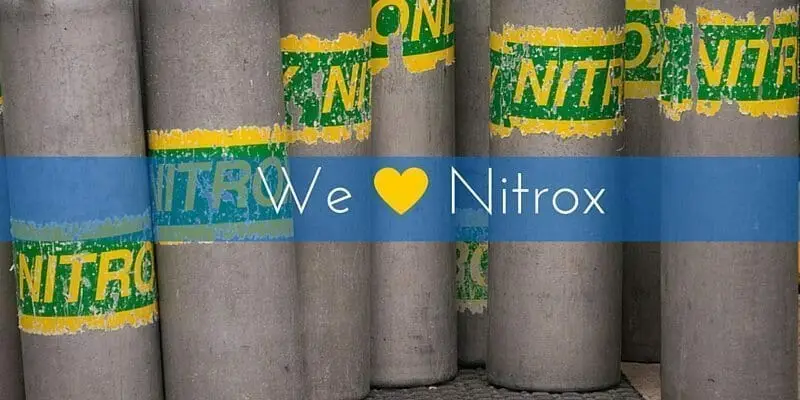
Diving with Nitrox In Palau
Imagine you are finally ready to start your long-awaited reefhook dive on Blue Corner.
Ever since you read that it was voted the best dive site in the world, it has been your dream.
You plan on dropping on the east reef, heading towards the bottom at 90 feet, then up to 75 feet to explore the cavern. The final part is to spend time hooked in on the plateau around 50 feet.
Your dive computer tells you that if you spend all your dive at 90 feet, you only have 20 minutes of bottom time.
That is not enough! This is why we encourage you to become a Nitrox certified diver when in Palau or when you get a chance before you come.
Depending on the nitrox mix you will use, you can now double your bottom time at the same depth. And that is what you want!
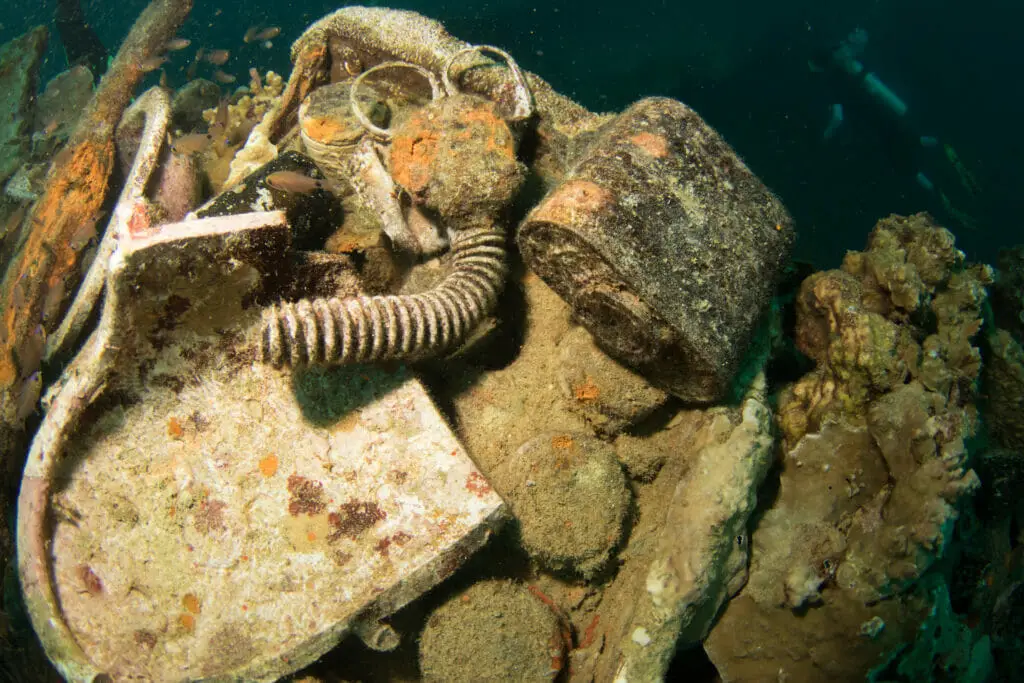
Wreck Diving Palau
When you think of Palau, the image of our great reefs, our best in the world drift dives, cavern dives, huge schools of pelagic species, and some of the best biodiversity in the world comes to mind.
Wrecks are not often near the top of the list. Thinking of wrecks brings nearby Chuuk (Truk) Lagoon to mind, after all, with over 60 WWII wrecks they are the “Wreck Capital of the World.”
Shh, lean a little closer to the screen. We have a secret to tell you.
We let them think they are the wreck dive capital of the world so that divers from around the world dive the “Ghost Fleet of Truk Lagoon.” Palau is known as the best for so many things; we feel it is only fair and being a good neighbour not to take the title “Wreck Capital of the World” from them.
Palau also has over 60 WWII wrecks, many of them considered a part of “the Lost Fleet of the Rock Islands.”
There is a good mix of wreck dive sites for both recreational divers and technical divers. While live munitions and deteriorated conditions make a penetration dive unsafe on many of the wrecks, some wrecks are available for penetration by trained divers.
Watch the Iro Maru Wreck
Want to see one of Palau’s most iconic WWII wreck dives before you descend? Our short video takes you underwater at the Iro Maru, showcasing its coral growth, swim-throughs, and haunting wartime history. Watch the Iro Maru video .
Private Charter in Palau
Private charters are ideal for families, groups of divers, very experienced divers, new divers, film crews, honeymooners and those who want total control of when and where they go.
Many guests of ours want to see Palau on their own schedule with their own group of friends or family and a private charter offers all of these benefits. If you and your family are newer divers or have junior divers this is the safest and most enjoyable way to experience Palau.
For those advanced divers, who want more action, custom private charters are a great way to keep all you advanced thrill-seeking divers.
A private charter can start as early as 7:30 AM and come back as later as 4 – 5 PM. This is a great way to beat the crowds and get to the dive sites early!
All private charters with us include:
- Fuel
- Palauan Boat Captain
- dive guide(s), tanks, weights
- Lunches
Private charters do not include
- Dive permits
- Rental dive gear
A typical dive day would include up to 3 dives per day or two dives per day and a trip to Peleliu or Jellyfish Lake. Of course, if you are nice to the crew they may stop by a couple of secret spots they have for snorkelling or showing some of the WW II history.
Liveaboard or Boat Diving in Palau?
When you come diving in Palau you will end up diving off a boat at some point whether it is a liveaboard boat or not.
And what better place to dive off a boat, but in a tropical paradise, surrounded by remote beaches, crystal clear water and reefs teeming with colourful reef fish.
Most of the dive boats that head out for a day of diving in Palau (and even the runabouts the liveaboards use) are all very similar.
Twenty-eight to thirty-five feet in length, twin outboards, canvas top for sun protection, and some type of bench seating for the divers.
This is the general configuration in Palau and it works well. The boats cruise around 23-27 knots and it takes approximately 45 minutes to reach the main dive sites.
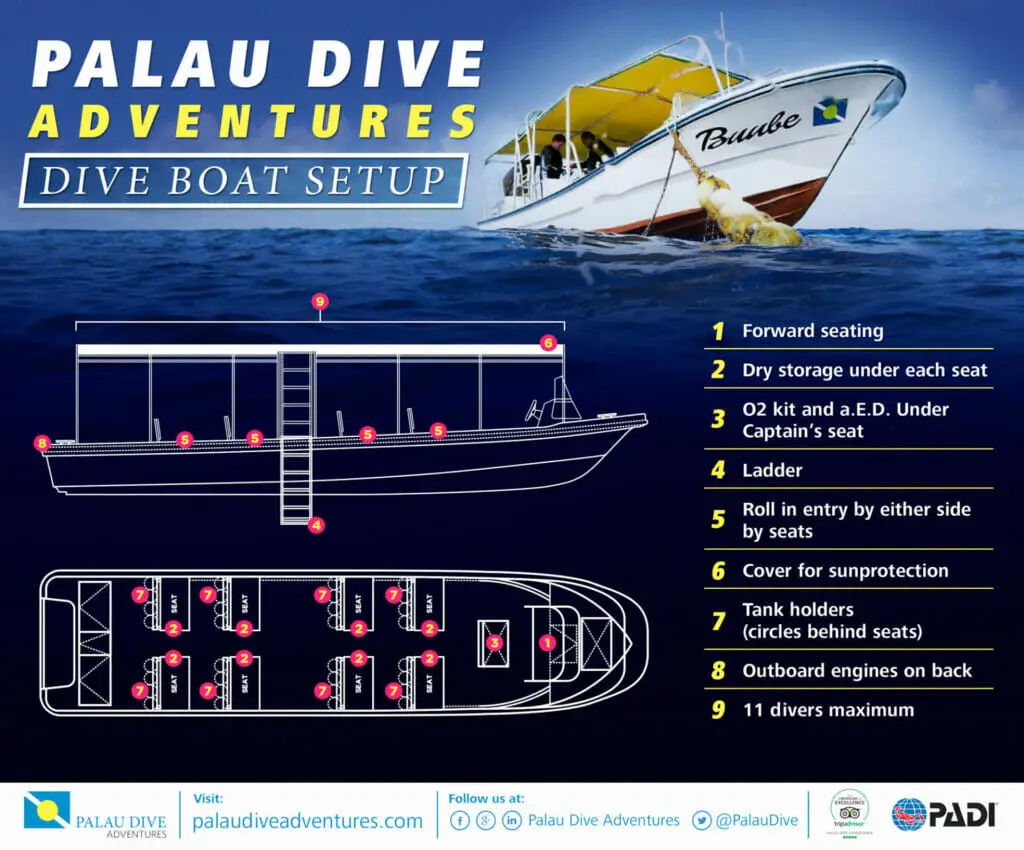
So whether you choose to do a liveaboard or you choose to dive with a land-based operation you will for 100% visit the same dives sites.
So the answer to the question, “Should I dive Palau from a land-based dive shop or should I go for a liveaboard” is… It depends.
The truth is both are great, and which option is better for you depends on your very own wants and needs.
- What do you want to do on your holiday?
- What is your budget?
- Do you just want to dive or do other things, too?
- Do you want to enjoy the culture and maybe get a bit of sightseeing done?
To help you get your head around it and decide what would be the best option for you we wrote an article How to Dive Palau, Liveaboard or Land-Based? providing you with all the relevant information to make an informed choice of what is best for your Palau diving holiday.
How to get to Palau?
There are only a handful of airports that offer direct flights into Palau, therefore getting to Palau can be a stretch but it will be worth it.
In short, when you are planning to travel to Palau, there are a few routes:
- To get into Palau from the USA you can take a direct flight from San Fransisco to Manilla and a direct connection into Palau.
- To get into Palau from Europe, you would fly to Manilla or Taipe, and from there you fly to Palau.
- To get into Palau South East Asia you will fly via Taipei or Seoul
- To get into Palau from Australia you can fly direct from Brisbane
Charter Flights
- Sky Angkor Airline from Macau
- Cambodia Airways from Macau
- Jeju Air from Seoul
We wrote an in-depth guide that explains in full detail how to get to Palau, make sure to read it.
Marine Life In Palau
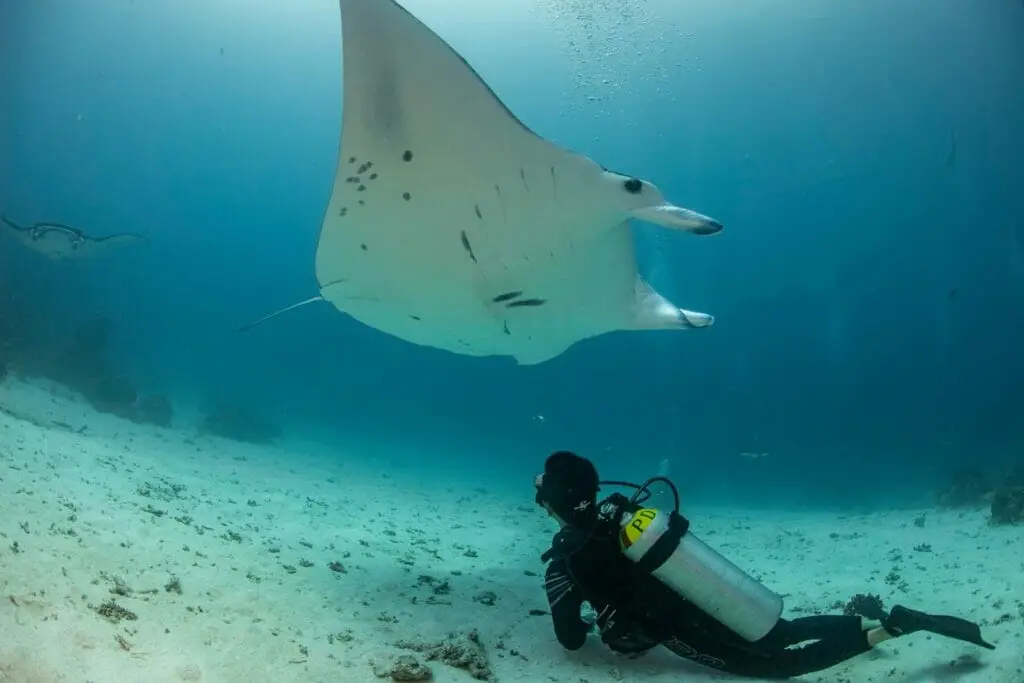
Sharks
Palau is famous for its sharks but that’s definitely not the only Marine life you will encounter when diving in Palau.
That said it is almost impossible to dive in Palau and not see a shark on almost every dive.
The most common sharks we encounter are:
March is one of the best months to come visit Palau in hopes of catching the sharks mating.
In Palau, we do not need to attract sharks by hosting a “shark feed”, they will do this naturally and sometimes if we are lucky we get to see it first hand!
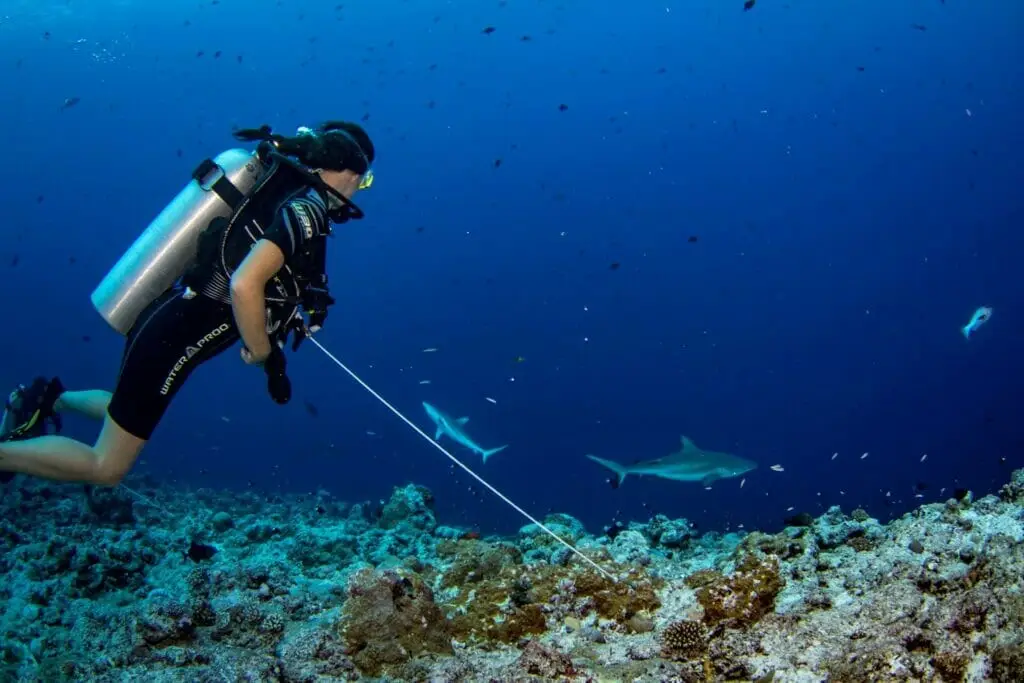
Manta Rays
Although not as common as sharks, In Palau, we have a couple of dive sites where we regularly see Manta rays.
German Channel is probably the most famous dive spot where Manta Rays can be found in Palau. For the Mantas Rays, German Channel is a cleaning station.
Cleaning Stations are certain locations where fish, mantas and sharks come to get their skin, gills and teeth cleaned by parasitic copepods and a variety of small cleaner wrasse species.
The mantas glide in against the current and hover just above the coral outcrop. Their bodies remain still, allowing the fish to do their job, meanwhile, photographers have a field day snapping away for the perfect shot.
On a good day, one manta swoops in right after another and sharks make their way in the lineup for a little teeth-cleaning action as well.
The winter months are by far the best time to find large groups of manta rays in Palau; January and February, in particular, can result in spotting dozens of manta rays in a single location.
Video: Secret Manta Spot
Reef Fish in Palau
Besides the “big stuff” like the Sharks, Mantas and dolphins there are a total of 1572 reported reef fish species living on the reefs of Palau.
You will find anything from the elusive Mandarin Fish, the non-stinging jellyfish in Jellyfish lake to the Giant Napoleon Wrasse.
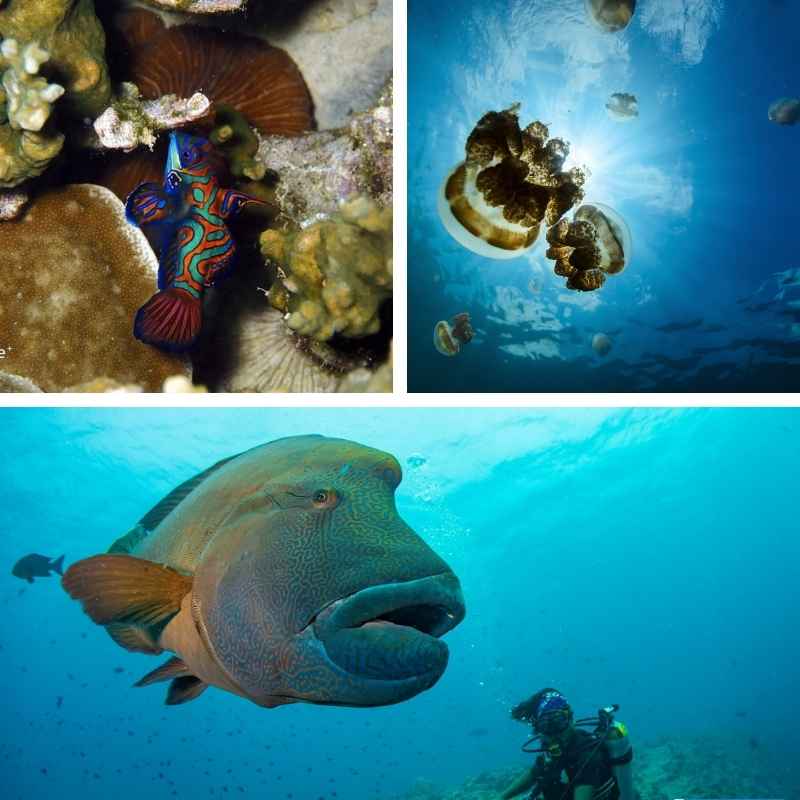
The Mandarin Fish is very seclusive and is best spotted at dusk and on cloudy days. Mandarin Fish Lake which lies in front of the entrance for Chandelier Cave is one of the few spots in Palau where you can spot this shy little fish.
One of the bigger fish that you’ll encounter on any trip to Palau, the Napoleon Wrasse can be encountered at shallow or deeper depths, ranging from one to sixty meters.
The fish measures up to two and a half meters in length and can weigh up to 200 kilograms, making it a formidable sight to behold.
The Napoleon Wrasse has a greenish-yellow colour and huge lips, making it very distinctive. It can protrude its teeth to snap up prey in nooks and crannies, and even shoots jets of water out of its mouth to force animals out of hiding.
Culture of Palau
The people of Palau, like other countries in Micronesia, have a rich culture whose roots are almost lost in time. Like other cultures elsewhere in the world, it is slowly disappearing. The culture of Palau is one that has most anthropologists confused.
It is believed the first residents of Palau were from South East Asia or Indonesia. These long-distance navigators seemly arrived 3,000 to 4,500 years ago, liked what they saw and stayed.
The first settlements are believed to be in the Rock Islands. Finally, inter-tribal warring led these settlements to move to Babeldaob.
Over time, they lost the desire and the knowledge of open ocean navigation and became experts on the territorial seas and the different seasons that come with it.
These early settlers add another mystery to the origins of Palau. In some parts of the island, the land has been terraced for agriculture. Unlike the similar terraces in the Philippines that were built up over hundreds if not thousands of years, these seem to have been made in a single large effort and in a much shorter time frame.
Carbon dating the material below the surface has been inconclusive as to when these terraces were developed. Some pottery shards test older than when the islands are believed to be inhabited, in fact, they date to some of the oldest in the world.
Palau Money Beads
Palau money beads a.ka The Udoud is a monetary system that existed long before the first Europeans reached the area. This “money” was in the form of pottery and glass beads, items that could not be made from local materials.
Each piece belonged to a class and had its own name and village elders would know the history of each piece within their clan. If you are interested in this sophisticated system, you will find this article, Money Walks, People Talk-Systemic and Transactional Dimensions of Palauan Exchange interesting.
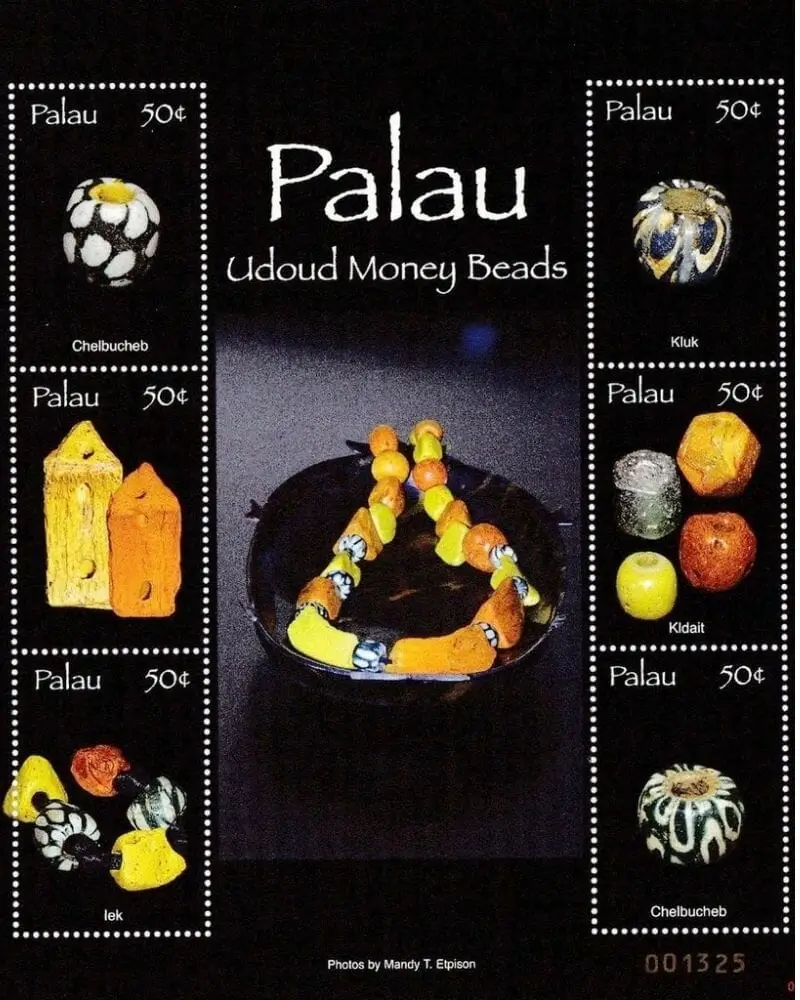
Other Things to Do in Palau
Of course, Palau is known for scuba diving, but, there is so much more to see.
As one of our guests put it: “There are SO many top-of-the-list world-class dive spots here, BUT, holy God does it wear you out!”
Below is a short list of a few must-sees and to do’s when you are in Palau and are not diving.
For a more extensive and detailed list make sure to read our post: 10 Palau Points of Interest.
Visit Peleliu Island
Visit Peleliu Island for a touching glimpse into a major World War II battlefield with various artifacts left behind. The Battle of Bloody Nose Ridge was one of the fiercest battles in the Pacific region. You can visit these impressive venues during a tour of Peleliu Island.
Throughout the island, many relics like tanks, ammunition, weapons, etc. can be seen overgrown by the jungle. Apparently, there is also a significant amount of live ammunition still in place off the beaten path, so travelers are advised to stay close to the tour guides.
Read More about >> Peleliu Island
Snorkel in Jelly Fish Lake
Visit Jellyfish Lake in Palau for a truly unforgettable experience. Jellyfish Lake offers everything that you could ever ask for, including clear, calm water and a close encounter with harmless non non-stinging Jellyfish.
Watch Jellyfish Lake
Curious what it’s like to float among millions of golden jellyfish? Check out our short video of Jellyfish Lake in Palau and see why this otherworldly site is one of Palau’s most iconic experiences.
Visit The Badrulchau Monoliths
Located at the northernmost point of Babeldaob you will find a series of stone monoliths. Legend has it these were placed there by a god to support the building of a Bai to hold all of his people. There are two columns of refrigerator-sized basalt monoliths, some with carvings of faces.
Basalt is a volcanic rock and Babeldaob is the only volcanic island in Palau. However, there is no Basalt near the surface of the island. The monolith has been dated to 161 A.D., raising the question further, where are they from and how did they get there?

Visit The traditional Palau Bai House in Babeldaob
In former times, each village in Palau used to have its own Bai house. At the beginning of the 20th century, more than 100 bais were still in existence in Palau.
The typical Palau Bai was used as a meeting hall for the governing elders. It is usually located in the middle of the village, on the village square and serves as the community center.
The Bai is made from fine hardwoods and elaborately decorated with ornaments and traditional designs and colors.
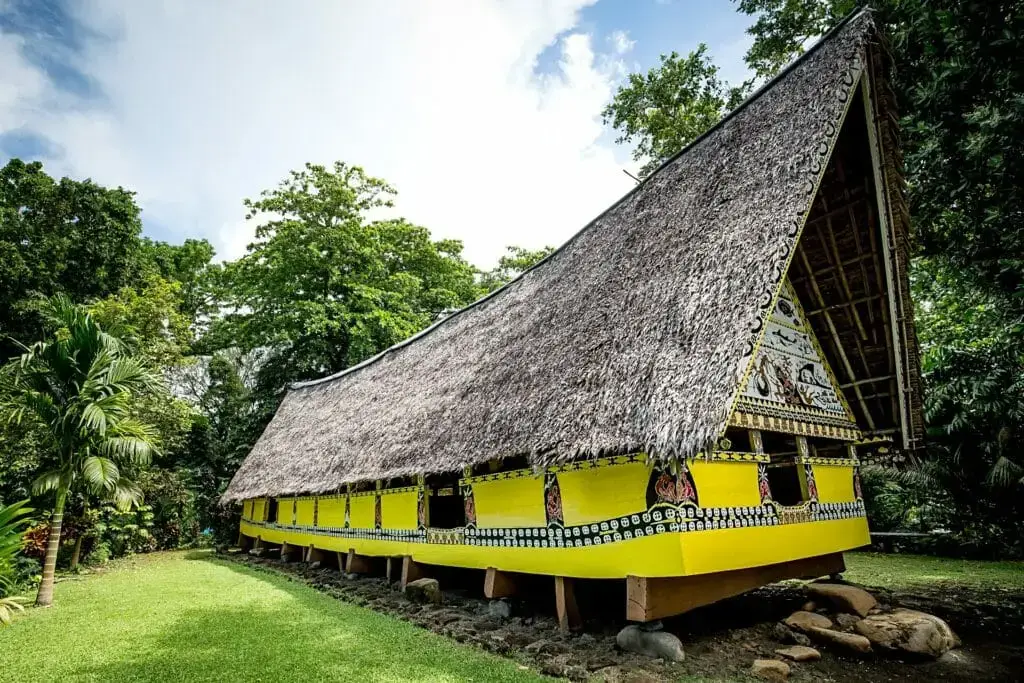
Visit the Palau Waterfalls
The Ngardmau Waterfall in Babeldaob is the largest waterfall in Palau. It is around 30 m high and 37 m wide.
As you follow it downstream, you can find beautiful little pools and miniature waterfalls.
During the hike to the waterfall, you can find historical remains of Japanese colonial times along the trail, such as an old locomotive and other parts of an old railway system.
If you’re not much of a hiking person, you can take the monorail or even a zip-line down to the Ngardmau Waterfall.
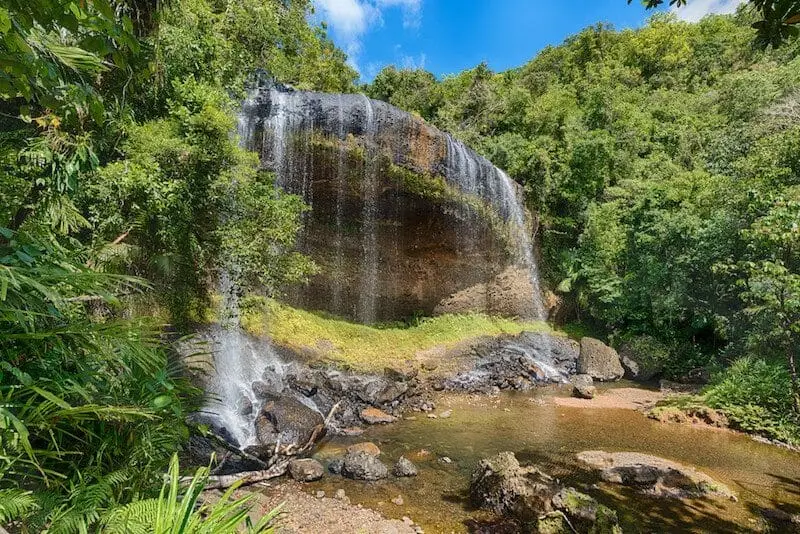
Kayak or SUP through the Rock Islands
The Rock Islands of Palau are known as one of the best locations in the world for kayaking and standup paddleboarding.
From around the world, people come for organized Kayak or SUP tours, individual safaris or to join day trips.
Most of the Rock Islands have no permanent structures and are seldom visited by other people.
As you paddle between the islands or into secluded coves, it is just you and nature. The clear water allows you to look down and see undisturbed reefs, sunken shipwrecks and even sleeping sharks.
The only “noise” you hear is nature and no crowds of tourists distracting you from what is around you.
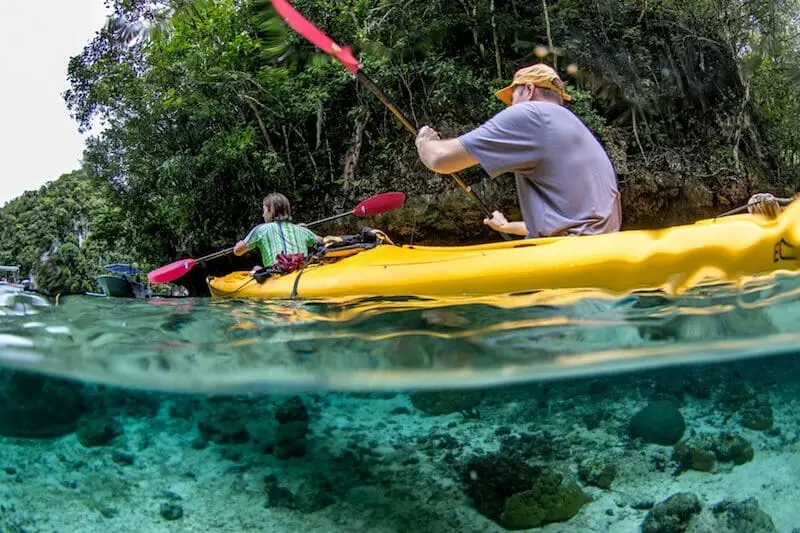
is Palau safe?
This is a question we get asked a lot. And the answer is; Yes, Palau is safe for tourists and anyone else, even after nightfall. The biggest common risk seems to be sunburn. When diving, make sure to carry scuba diving insurance. We also recommend travel insurance, just in case.
The U.S. Department of State has assessed Koror as being a LOW-threat location for crime directed at or affecting official U.S. government interests.
The most common type of crime is burglary and petty theft. Most occurrences of theft involve unattended items at hotels and at the Roman Tmetuchl International Airport (ROR) in Airai.
Time zone Palau
Palau Time – is abbreviated as PWT. Palau is 9 hours ahead of Greenwich Mean Time (+9 GMT) and does not observe daylight savings time and therefore Palau is on UTC + 9 standard time year-round.
Palau Travel Tips
Do you need a Visa for Palau?
Upon your arrival in Palau, you must have a valid passport no less than six months from the date of expiry and proof of return arrangements. (It is best to have your travel confirmation printed out since there is no free WiFi at the airport).
A 30-day Tourist Visa will be issued upon arrival; except for citizens of Bangladesh and Myanmar, who must obtain a visa in advance for entry.
- A 90-day Tourist Visa are available for citizens of Israel.
- A one year Visa may be obtained on arrival for Marshallese, Micronesian, and US/American Samoan citizens.
- Upon departure, there is a protected ar
Currency of Palau
Palau’s currency is the US Dollar, and you will find banks in all the major tourist areas. Credit cards are widely accepted in tourist areas.
Tips are expected in restaurants, taxis, and baggage handling. You can find ATMs for international withdrawals at the Bank of Hawaii, the Bank of Guam and the Bank Pacific in Koror.
Foreign currency exchange can be complicated, so remember to bring US dollars.
The only bank to exchange most major currencies is the Bank of Hawaii.
Note that there will be a service charge of US$10 per transaction.
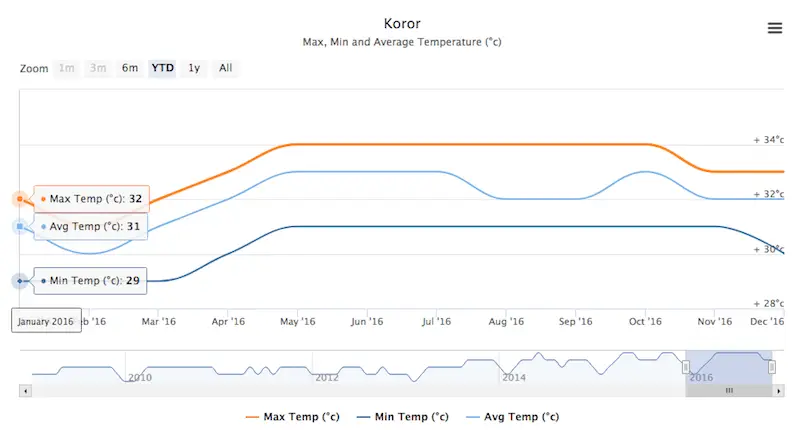
Do I Need a Power plug-in Palau?
Electricity in Palau is 110 Volts, 60 Hz. If you travel with a device that does not accept 110 Volts at 60 Hertz, you will need a power plug for Palau.
If your electric appliances are made for 110 – 127 V (as is in the US, Canada, and most South American countries) you can use them in Palau.
Manufacturers take small deviations (plus or minus 5%) into account. Be careful if you bring appliances from Japan (100 V). If the standard voltage in your country is 220 – 240 V (as is in the UK, Europe, Asia, Africa and Australia), you need a voltage converter in Palau.
If you are not sure, check the label on the electric appliance. Some appliances do not need a converter. A label that says ‘INPUT: 100-240V, 50/60 Hz’ means, that this appliance can be used everywhere in the world. This is mostly true for the chargers of tablets/laptops, photo cameras, cell phones, toothbrushes, etc.
Do you need Vaccinations when traveling to Palau?
Steps for Entry: Covid-19 Vaccination
All travelers must provide valid proof of full COVID-19 vaccination, with the final dose received at least 14 days prior to departure to Palau.
Click here to access the arrival health declaration form.
Vaccine records must clearly show the date(s) and the number of dose (s) received as well as the vaccine brand that is either US FDA or WHO approved or authorized for COVID-19.
Unvaccinated travelers under eighteen (18) years of age may enter Palau and shall undergo the same requirements for vaccinated travelers.
All travelers must provide a valid address and contact information in Palau and undergo a self-monitoring period for five (5) days from the date of arrival (see Mitigation Orders).
Travelers will monitor their health, and if they develop symptoms during this time period, they should isolate themselves immediately and get tested.
All travelers are required to wear their face masks at all times during their self-monitoring period.
When traveling to Palau, make sure you have the basic immunization against vaccines including the measles-mumps-rubella (MMR) vaccine, diphtheria-tetanus-pertussis vaccine, varicella (chickenpox) vaccine, polio vaccine up to date. Vaccination against Hepatitis A and Typhoid is recommended.
Is the water in Palau safe to drink?
It is not recommended to drink tap water. Stick to bottled water to be on the safe side.
Is there a hospital in Palau?
Palau has only one hospital, the Belau National Hospital and it is located in Koror. It provides primary health care services, emergency care, surgery, inpatient, pediatric and outpatient services.
Belau National Hospital has basic radiology equipment, CT scan, X-rays, and mammogram.
It has the only decompression chamber for diving-related accidents. In severe cases, patients will be evacuated to Manila for treatment.
We strongly recommend obtaining travel insurance and dive insurance before your trip to Palau.
Emergency numbers/ deco chamber
- The emergency call number in Palau is 911.
- Belau National Hospital: Administration: 488-2552
- Emergency Room: 488-2558
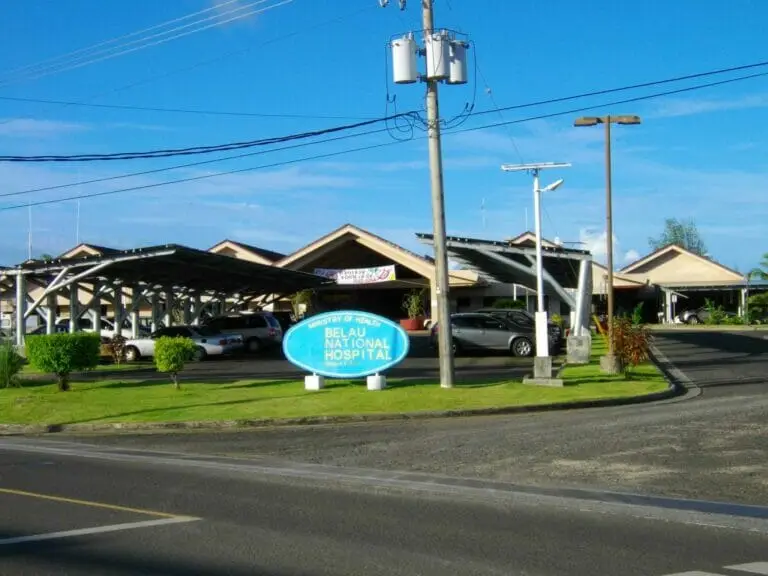
Language of Palau
The language spoken in Palau is Palauan, and luckily the second official language is English. Other common languages include Japanese and Tagalog.
Especially the older generation speaks Japanese well, and it is the official language of the state Angaur. Tagalog is spoken as the fourth common language due to a large Filipino community on Palau.
The largest part of Palau’s population is Christians, with the Roman Catholic Church holding most members, about 65%. Other denominations such as the Evangelical Church, the Seventh-Day Adventists, The Church of Jesus Christ of Latter-Day Saints, and Jehovah’s Witnesses also exist.
The Indigenous Religion of Palau is the Modekngei religion. It combines pagan and Christian beliefs. There are also some Bangladeshi Muslims.
Diving Palau with PDA. What to expect?
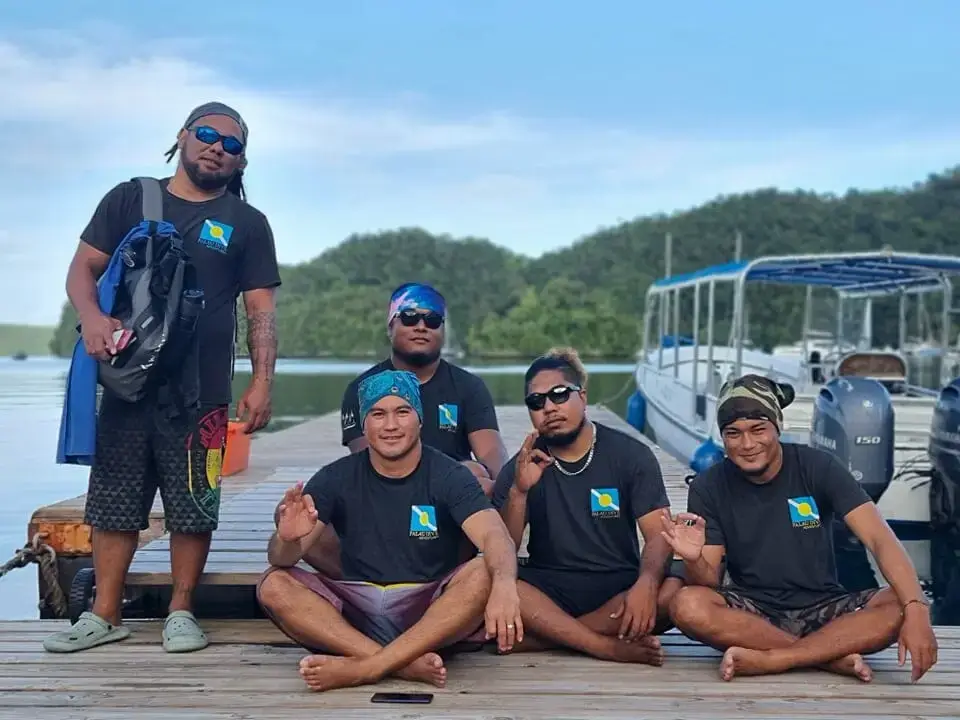
Our standard dive week is an unusual maybe even unique arrangement for a land-based operation. It has some of the elements you would only expect to find on a liveaboard.
Our dive week starts on Monday and runs through to Friday and includes 13 dives a trip to Jellyfish Lake, Peleliu Island and we offer complimentary nitrox for EANx certified divers. This is our signature package, and it is limited to a maximum of 10 divers per week!
A dive week like this gives you some advantages:
- You will be diving with the same group of divers all week, so you will get a chance to know your fellow divers and the PDA crew.
- You will bring your gear on either Sunday or Monday, after that we valet your dive gear the entire week.
- If you need to rent dive gear, you will have the same gear for the week, there is no reason to be fitted for rental equipment each day.
- As we dive as a group, no “outsiders” will show up at the last minute to join. Possibly delaying a departure as they fill out forms, get their c-card verified because they forgot it and get fitted for rental gear.
- One of the things that many of our guests have found a huge plus is our dive schedule.
Unlike the standard process where you are told where you are going, our guests tell us where they would like to go, and we build our weekly dive schedule around it.
On Monday, at the start of the dive week when the introductions are finished, the dive guides and guests will discuss their certification and skill levels and also if any specific dive sites are on their bucket list.
Our experienced and local dive guides will create a custom week’s dive schedule. Weather and marine conditions might cause some modifications. However, the desires of our guests will still be included in the plan.
We work with a select few accommodations over the range of budget, standard hotels, and luxury resorts.
We have negotiated rates with these properties, so you do not have to. We understand that our reputation is also affected by our recommendations, so you can be sure that we have been very careful in our selections for each category.
If you are a diver that truly wants a dive vacation, then you should surely consider planning your next dive trip to Palau.
P.S. If you’re dying to come to Palau for the first time but have no idea how to pull it all together, give us a call at our U.S. office (310 321-2558), or contact us directly via our contact form and we’ll help you figure it out. Sometimes getting clear, informed answers makes all the difference!
Palau offers world-class drift dives, abundant sharks and mantas, vibrant coral walls, historic WWII wrecks, and rare marine life, making it a cinematic bucket-list destination.
While diving is excellent year-round, December–April is ideal for calm seas, clarity (50 m+ visibility), and peak marine activity.
Expect encounters with sharks, manta rays, bumphead parrotfish (during spawning), dugongs, Napoleon wrasse, and diverse coral reefs, especially during full/new moon windows.
Blue Corner: Legendary for reef-hook drift dives, sharks, and visibility up to ~90 ft.
Ulong Channel: Premier drift site with giant clams and lettuce coral.
German Channel: Historic man-made cut with calm currents great for macro and easy entrance.
Jellyfish Lake: Snorkeling only unique, permit-based experience; scuba diving is prohibited due to anoxic depths
Advanced Open Water (to ~30 m) is highly recommended for sites like Blue Corner. Nitrox is highly beneficial because it extends your overall bottom time
Absolutely. Spawning aggregations—such as bumphead parrotfish or snapper occur at lunar peaks. Timing trips precisely around new and full moons elevates the dive experience
Palau leads globally in marine protection:
First shark sanctuary (2009)
Marine National Sanctuary protects 80% of its waters
Reef-safe sunscreen ban (2020)
Mandatory “Palau Pledge” for visitors
These measures ensure spectacularly healthy ecosystems.
Beyond diving, visitors can enjoy traditional carving workshops, stone monoliths and WWII history tours, museum visits, jungle waterfall hikes, kayaking among the Rock Islands, and vibrant night markets.
Yes significantly. Since December 7, 2024, Qantas has launched the “Palau Paradise Express”, a weekly nonstop Boeing 737 flight between Brisbane and Palau (Koror)
Flight time: around 6 hours one way
Some report it feels even shorter—around 5.5 hours—highlighting how seamless the connection is.
Initial launch fares were approximately AUD 899 return, with some promo deals starting at AUD 720.
This service has dramatically improved access for Australian travelers, eliminating long flights and multiple transfers. The streamlined route makes Palau more accessible and attractive for divers from Australia.
There are no direct flights from the mainland U.S. to Palau. However, reaching Palau is fairly streamlined with just one connection, typically via East Asia or Guam.
Common routes include:
San Francisco → Manila → Palau (via Philippine Airlines and United)
Los Angeles or Honolulu → Tokyo Narita → Palau (via United)
Any U.S. gateway → Guam → Palau (via United)
Other connecting hubs from Europe or Asia include Tokyo, Taipei, or Manila, which are convenient for multi-country Asia-Pacific itineraries.
There are no nonstop flights, so careful planning around schedules and transfers is essential.
There are no direct flights from Europe to Palau. Travelers typically fly via Tokyo, Taipei, or Manila before connecting onward to Palau with regional carriers such as China Airlines, United Airlines, or Asiana.
Typical duration: around 24–26 hours, including layovers.
Estimated round-trip cost: usually between €1,800 and €2,500, though prices were lower previously (€1,200–€1,600).
Yes! Palau is safe, low-crime, and well-managed. Belau National Hospital in Koror includes a functional hyperbaric chamber and trained barotrauma staff. Still, dive insurance and evacuation coverage remain critical.



